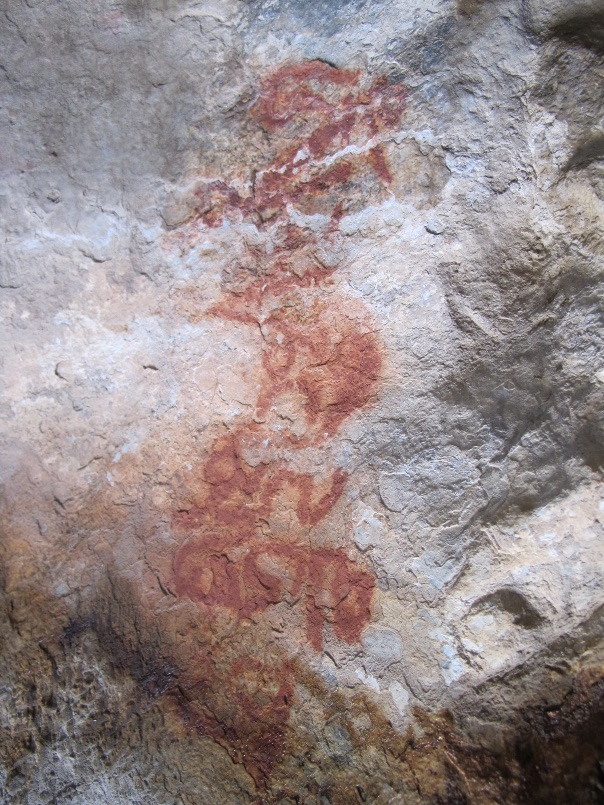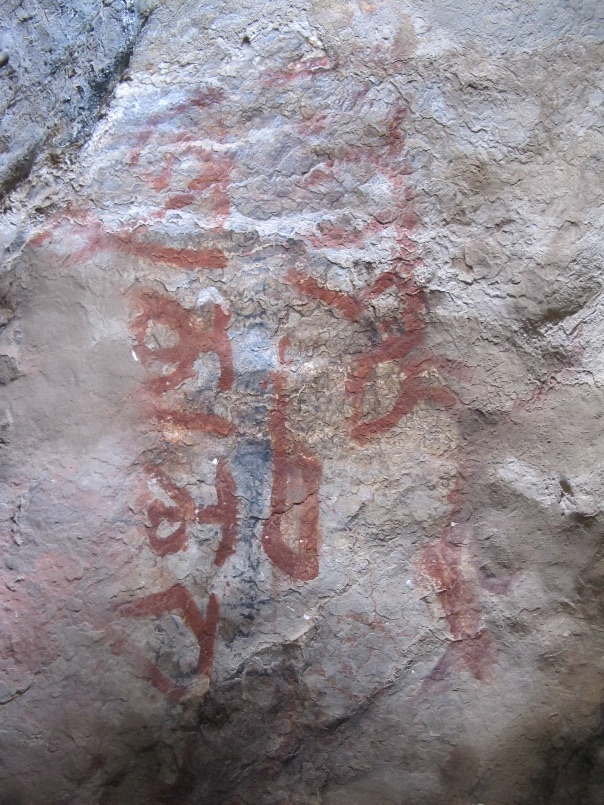Inscription decipherment with digital image enhancement
« previous post | next post »
John Bellezza, an archeologist and cultural historian whose work focuses on the pre-Buddhist heritage of Tibet and the Western Himalaya, and who has lived in high Asia for three decades, sent me the following two photographs of inscriptions that he took at Lake Gnam-mtsho, Tibet (TAR):
Weathered, faded, and somewhat effaced, they are difficult to read. John hypothesized that they might be written in Proto-Sarada, which would make sense for the time and area where he found them.
The Śāradā, Sarada or Sharada script is an abugida writing system of the Brahmic family of scripts. The script was widespread between the 8th and 12th centuries in the northwestern parts of Indian Subcontinent (in Kashmir and neighbouring areas), for writing Sanskrit and Kashmiri. Originally more widespread, its use became later restricted to Kashmir, and it is now rarely used except by the Kashmiri Pandit community for religious purposes.
It is a native script of Kashmir and is named after the goddess Śāradā, (another name for Saraswati, the goddess of learing), the main deity of the Sharada Peeth temple.
(source)
For a monograph on Sarada, see:
Slaje, Walter, 1993. Śāradā: Deskriptiv-synchrone Schriftkunde zur Bearbeitung kaschmirischer Sanskrit-Manuskripte. Auf der Grundlage von Kusālas Ghaṭakharpara-Gūḍhadīpikā und unter graphischer Mitwirkung von Eva Slaje. (Indische Schriften, Band 1.) Reinbek: Dr Inge Wezler Verlag für Orientalische Fachpublikationen. 118 pp. ISBN 3-88587-016-9.
This Śāradā primer treats only manuscripts in standard Śāradā script from mainly the Kashmir region.
For epigraphic Śāradā, which shows great variety depending on the period and region, as it was used far beyond the valley, see:
Bhushan Kumar Kaul Deambi, Śāradā and Ṭākarī Alphabets. New Delhi: D.K. Printworld, 2008.
ISBN 13: 9788124604120
When I first sent the photographs out to Sarada specialists, I did not know the location where the photographs were taken, so I was unable to tell them where the inscriptions were from.
Nonetheless, John Mock quickly responded:
I ran the images through the DStretch algorithm (using imageJ) and the letters popped.
I've attached jpgs of the DStretch images.
Not Sarada. Tibetan.
1316 reads "om mani padme hum", which you'll recognize as the "hail to the jewel in the lotus" mantra.
1317 looks like the top "line" is actually a stick figure of a horned animal, (you can see the rectangular head). A cervid stag I'd guess, and the "fifth" leg may be a penis – can't be sure, but what appear to
be elongated horns would fit with that "view".
The line below is also Tibetan – not well composed though.
The first letter is ཨ (a-chen) with what looks like a "shap-chu" (u vowel sign), i.e. ཨུ , but the vowel sign is maybe not correctly written (sort of backwards).
The second letter is clearly མ་ "ma".
The third letter should be "na" ན་, but it looks more like "cha" ཆ with a "ki-ku" ('i') vowel sign above. Whoever wrote it was probably trying to write ནི (ni).
The fourth letter is "pa" པ་ . To the right maybe there is more, but not readable / visible for me in this image.
The writer was probably trying to write "om mani padme hum" but either didn't finish it, or it is effaced. I don't know any other "mantras" that would fit, though a better-trained Tibetan scholar might know
something.
That's what I see. Let me know if you see anything else.
As for provenance, so far nothing stated, but the image file name starting with UT makes me think of "Upper Tibet", which would fit the content.
The red color is standard/typical of Tibetan pictographs and mantras on rock.
Here are the two inscriptions as rotated and digitally enhanced by John Mock with DStretch:
John Mock continues:
The software algorithm DStetch®, short for Decorrelation stretch, is an image enhancement technique first used in remote sensing that can be usefully applied to rock art. NASA has used it to enhance Mars Rover images. See Harman, Jon, “Using Decorrelation Stretch to Enhance Rock Art Images”, at www.DStretch.com. ("DStretch uses decorrelation stretch. This is an image enhancement technique first used on aerial photos. For an explanation of how it works see the algorithm description.")
It runs as a plug-in for ImageJ, a public domain Java image processing and analysis program inspired by NIH Image for the Macintosh. Downloadable distributions are available for Windows, Mac OSX and Linux.
DStretch works really well on pictographs where pigment is effaced or blurred. It also helps with rock-cut epigraphs. I've used it on Old Tibetan inscriptions in Wakhan with good results. It's especially helpful in revealing layers in a palimpsest. It can even help with worn inscriptions on bronze.
Another easy technique for rock is taking multiple exposures from varying angles and then using software such as Agisoft Photoscan Pro to compile the images into an enhanced 2D / near-3D model. It's very helpful with heavily weathered inscriptions.
A DStretch reference:
Jean-Loïc LeQuellec, Frédérique Duquesnoy, Claudia Defrasne 2015, "Digital image enhancement with DStretch : Is complexity always necessary for efficiency?" Digital Applications in Archaeology and Cultural Heritage 2 (2015) 55–67.
http://dx.doi.org/10.1016/j.
This is a good example of how advanced digital technology can assist archeological research. I already know half a dozen colleagues who will be using it in their investigations just from having been exposed to it through the draft of this post.
[Thanks to Asko Parpola, Harry Falk, Ingo Strauch, Lore Sander, Joe Cribb, Oskar von Hinüber, Jason Neelis, and Huashan Chao.]




Jonathan Silk said,
December 2, 2020 @ 3:22 am
The first part of the inscription is 100% readable although one can slightly improve on the remarks of John Mock.
I'm sorry I can't quickly figure out how to type this in Tibetan, but the first letter is a, with an a-chen (usually romanized independently as ', though linguists prefer ḥ), giving the sense of the long vowel ōṁ. ma + ṇi (the backwards ni indicates retroflexion) pa dme huṁ.
For the second inscription, I am not certain about the first line, but the second again has the ḥ below a, not any u vowel. I think with some generosity we could see again a ṇi, perhaps with a gi gu log above it, although it looks upside down (?). the software by the way is really helpful, wow.
Dieter Maue said,
December 2, 2020 @ 4:53 am
An additional note:
Subscribed a chung (འ) as mark of vowel lengthening (in non-Tibetan words) is also present in hūm̆̇.
Jonathan Silk said,
December 2, 2020 @ 7:39 am
@Dieter
ach, silly of me, I too quickly took that as part of the ha, but of course you are right. The ha is written in a quite abbreviated way, intertesting.
John Vincent Bellezza said,
December 2, 2020 @ 8:29 am
Clear as a bell when oriented correctly and digitally enhanced. The second epigraph is an incomplete mani mantra. The superscribed mark possibly a vowel sign.
Location Gnam-mtsho, Tibet (TAR). Very common mantra and these two examples probably post-dating 1000 CE.
Dan Martin said,
December 2, 2020 @ 8:32 am
There ought to be a study of this somewhere, but the â (Tibetan a-chen with subscribed 'a-chung [yes, I know, use of this term is mildly controversial] indicating a lengthening of the vowel) may be a sign of age or sectarian identity. It's presence makes it look both old (as in some Dunhuang examples of Om in Tibetan letters; Sam van Schaik did a blog about them) and possibly later Nyingma (Old School) who still tend to spell it that way (as much as it may be arguably unnecessary, still it is just a fact that early transcription practices differed from later).
In the 2nd inscription, its enhanced version of course, I immediately see a-mchod (with a single shad punctuation at the end). I first encountered this word years ago in a 1951 article by a missionary to Amdo, M. Hermanns, when browsing through an old journal in the anthropology library in Harvard. It's accompanied by a photograph of an A-mchod.
I must have known this would be needed someday, since I xeroxed it and filed it away. The photo has this label: "A follower of the oldest Tibetan creed. He is called A mchod which means sacrificer. His hair is tied in a knot on the top of his head. The ends hanging over his left shoulder are lengthened by yak or horse hairs."
Rev. Matthias Hermanns, SVD, Tibetan Lamaism up to the Time of the Reform by Tsoṅ kha pa, The Journal of the Anthropological Society of Bombay, n.s. vol. 5, no. 2 (1951), pp. 7-36.
I should emphasize that Hermanns does not indicate that the A mchod has anything to do with Bon religion. He tries to represent several religious schools in his article and its photos, and gives Bon its own independent category.
The word isn't much used, sometimes it seems to have different usages, and I think C. Ramble of Paris has discussed it more recently. I'm thinking if Hermanns is right and its proper meaning is 'sacrificer,' it might make sense to put it under an image of a sacrifice-able animal, but who am I to tell?
Dan Martin said,
December 2, 2020 @ 9:28 am
Okay, I hadn't seen John's comment when I went mine, but I can see that what he sees there is entirely possible, and actually with a much higher degree of probability to occur as a graffito. Even so, I can still see what I saw, although I seem to be backing down from seeing it a little, especially since the initial 'a' does have what looks like a length mark beneath it, and that doesn't seem so likely to happen with the Amdo Tibetan a-mchod priestly title.
Dan Martin said,
December 2, 2020 @ 9:28 am
"sent mine," not "went mine"
John Vincent Bellezza said,
December 2, 2020 @ 11:06 pm
Dan Martin wrote: "but the â (Tibetan a-chen with subscribed 'a-chung [yes, I know, use of this term is mildly controversial] indicating a lengthening of the vowel) may be a sign of age or sectarian identity." I concur with these observations and discuss them in my new book on Tibetan inscriptions:
2020. Drawn and Written in Stone: An Inventory of Stepped Shrines and Early Rock Inscriptions in Upper Tibet (ca. 100 BCE to 1400 CE). British Archaeological Reports International Series, vol. 2995. Oxford: BAR Publishing.
There are scripts and orthography characteristic of Buddhist and non-Buddhist sects in the ancient rock inscriptions of Upper Tibet, and these are just as telling as the contents of the inscriptions.
Victor Mair said,
December 5, 2020 @ 1:52 pm
From Oskar von Hinüber:
As you have seen yourself the first inscription is "Tibetan": padme hum is clearly readable, so that is easy, although it seems that something follows after hum. The inscription sent first in Proto-Sarada looks pretty hopeless, even after putting the image into the right position: it is "spiegelverkehrt". The last charactter seems to be sya which points to a name. The rest is obscure to me so far. As soon as (or if) I have an illumination, I shall let you know. If any body else has, please let me know.